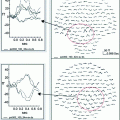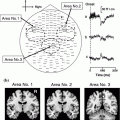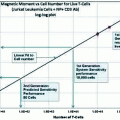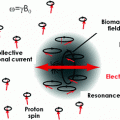Fig. 1
System configuration of the child MEG
The appearance of the child MEG system installed in an MSR at the Australian Hearing Hub at Macquarie University is shown in Fig. 2. The MSR is made of three mu-metal layers, and it houses two MEG systems. The child MEG system is to the left and a conventional adult MEG system is to the right in the figure. Like the adult MEG, the child MEG system has the gantry-free structure designed for subjects in a supine position (Kado et al. 1999). The supine position is effective for suppressing the movement of the subject’s head during the measurement. Similar child MEG and adult MEG systems are installed in an MSR at the Department of MEG, Yokogawa Electric Corp.
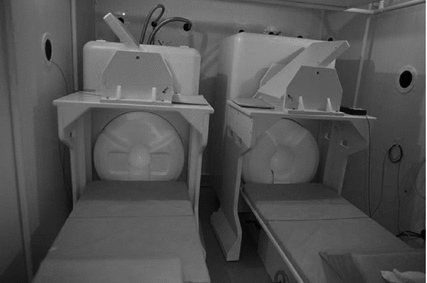

Fig. 2
Appearance of the child MEG system (left) and the conventional MEG system (right)
2.2 Sensor Array and Dewar
The sensor array comprises 64 LTS-SQUID axial-type first-order gradiometric magnetometers. Niobium-based LTS-SQUIDs known as Ketchen type (Jaycox and Ketchen 1981; Ketchen and Jaycox 1982) are used. The pick-up coil made of niobium thin wire with a 15.5-mm diameter and 50-mm baseline length is wound around a bobbin and coupled with the input coil of each LTS-SQUID mounted at the top of the bobbin. The typical noise characteristics of the sensor are less than 10 fT/Hz1/2 at 1 Hz and less than 5 fT/Hz1/2 at 100 Hz. The number of SQUID sensors is expandable up to more than one hundred by reconfiguration with additional sensors. The sensor array is helmet-shaped and its size is about 200 mm in diameter and about 530 mm in circumference. These dimensions were determined on the basis of a preliminary investigation of the standard size of preschool children’s heads. This size was about 20 % less than the size of the conventional adult MEG sensor array.
The dewar to store liquid helium is of a horizontal type and is optimized for the measurement in the supine mode. The sensor array described above is positioned inside the dewar at the helmet side. The size of the helmet for the child MEG system is shown in Fig. 3 in comparison with that for the conventional adult MEG system. The angle of view was designed to be wider than that for the adult MEG system to broaden the field of vision during the measurement. This wide angle of view is effective for preventing the children from feeling claustrophobic. The cool-to-warm separation at the helmet-shaped part is 20 mm. The liquid helium capacity of the dewar is roughly 100 L, and the helium consumption rate is less than 6 L/day. The sensor array is assembled using the ship–in–a–bottle approach (Kado 1999), a method used to assemble our adult MEG systems. This technique enables the diameter of the opening to access the dewar to be kept smaller than the total size of the sensor array and, as a result, to reduce the liquid helium consumption rate.
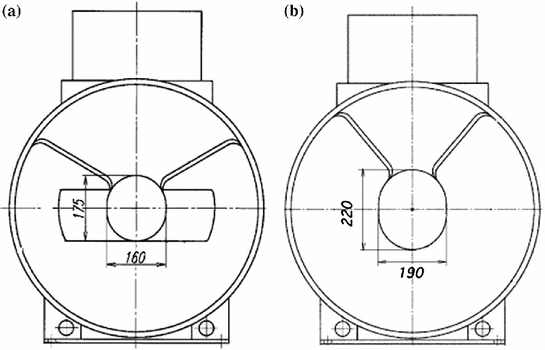

Fig. 3
Front view of the dewars (a) for the child MEG and (b) conventional MEG systems
The dewar and the sensor array are made of glass-fiber reinforced plastic (GFRP). It is non-magnetic and effective in preventing magnetic artifacts. However, it is known that GFRP can be mechanically distorted when it is cooled in liquid helium, and a sensor can inevitably be dislocated from its originally designed position. The displacement is not predictable before cooling and it is not negligible in view of the accuracy of magnetic source analysis. Therefore, the positioning and calibration of each sensor is performed after cooling using a precisely machined array of coils and standard electric current to produce standard magnetic fields (Higuchi et al. 1989).
2.3 Flux Locked Loop (FLL) and Data Acquisition Unit
A double-integrator-type FLL based on a direct offset integration technique (DOIT) (Drung et al. 1990; Adachi et al. 2007) is adopted to linearize the flux-voltage characteristics and to improve the dynamic range of the SQUID signal. The second feedback loop of the FLL provides an automatic offset adjustment. Consequently, the effective frequency range of the FLL is 0.16 Hz–5 kHz. Therefore, this FLL is also called a band-pass type FLL.
3 Comparison with the Conventional MEG System
Pioneering works using the whole-head child MEG system were reported by Johnson et al. (2010). Measurements of the auditory evoked field (AEF) from preschool children were performed using both the child MEG system and the conventional MEG system. The position of the child’s head relative to the sensor array was obtained by marker coil measurement prior to each MEG measurement (Erné et al. 1987). The conformity of the children’s heads to the child MEG helmet and the conventional MEG helmet was evaluated based on the analysis of the sensor-head center distance. The fit of the child MEG helmet to the children’s heads was comparable to or better than that typically achieved for adult heads with a conventional MEG system. The head of a 4-year-old child could not be fully inserted into the adult helmet owing to the smaller crown-neck distance, and symmetrical lateral positioning in the adult helmet could not be achieved and maintained without the insertion of shim pads in the temporal regions.
Stay updated, free articles. Join our Telegram channel

Full access? Get Clinical Tree



